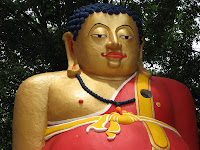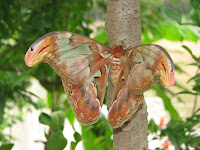 In this part of Northern Lao are many different hilltribes who came from China,
In this part of Northern Lao are many different hilltribes who came from China, Tibet, Mongolia, and Myanmar. We did a two day trek through the jungle and stayed in an Akha Hilltribe village. We had a lunch of barbequed water buffalo, young bamboo shoots, acacia leaves fried with onion, garlic and chillies, sticky rice, and other jungle plants that we don't know the names of. It was a lovely setting beside the waterfall.
Tibet, Mongolia, and Myanmar. We did a two day trek through the jungle and stayed in an Akha Hilltribe village. We had a lunch of barbequed water buffalo, young bamboo shoots, acacia leaves fried with onion, garlic and chillies, sticky rice, and other jungle plants that we don't know the names of. It was a lovely setting beside the waterfall.On the trek were a couple from Switzerland, a German and us. We had 2 Akha guides and a Lao guide who all spoke English. None of us escaped the leeches that live on the jungle foor. This fat one on John's sock had a feast on him.

The villagers cooked for us (turkey and jungle vegetables), sang and danced for us, massaged us, entertained us, and answered all our questions. An enlightening experience.
The children played to the cameras!
 The villagers worship spirits and have a swing festival to mark the Lao New Year- the date is set by the village leaders. Each village has a spirit gate that cannot be touched and a new one is built each year.
The villagers worship spirits and have a swing festival to mark the Lao New Year- the date is set by the village leaders. Each village has a spirit gate that cannot be touched and a new one is built each year. 

























 Kapok seeds.
Kapok seeds.
 We visited all the Wats (temples) of note on a hot 40 degree day.
We visited all the Wats (temples) of note on a hot 40 degree day.


